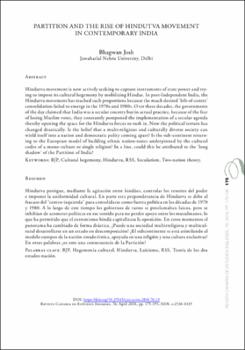Partition and the Rise of Hindutva Movement in Contemporary India
Author
Josh, BhagwanDate
2018Abstract
Hindutva persigue, mediante la agitación entre hindúes, controlar los resortes del poder e imponer la uniformidad cultural. En parte esta preponderancia de Hindutva se debe al fracaso del “centro-izquierda” para consolidarse como fuerza política en las décadas de 1970 y 1980. A lo largo de este tiempo los gobiernos de turno se proclamaban laicos, pero se inhibían de acometer políticas en ese sentido para no perder apoyo entre los musulmanes, lo que ha permitido que el extremismo hindú capitalizara la oposición. En estos momentos el panorama ha cambiado de forma drástica. ¿Puede una sociedad multirreligiosa y multicultural desarrollarse en un estado en descomposición? ¿El subcontinente se está asimilando al modelo europeo de la nación-estado étnica, apoyada en una religión y una cultura exclusivas? En otras palabras ¿es esto una consecuencia de la Partición? Hindutva movement is now actively seeking to capture instruments of state power and trying to impose its cultural hegemony by mobilizing Hindus. In post-Independent India, the Hindutva movement has reached such proportions because the much desired ‘left-of-centre’ consolidation failed to emerge in the 1970s and 1980s. Over these decades, the governments of the day claimed that India was a secular country but in actual practice, because of the fear of losing Muslim votes, they constantly postponed the implementation of a secular agenda thereby opening the space for the Hindutva forces to rush in. Now the political terrain has changed drastically. Is the belief that a multi-religious and culturally diverse society can wield itself into a nation and democratic polity coming apart? Is the sub-continent returning to the European model of building ethnic nation-states underpinned by the cultural codes of a mono-culture or single religion? In a line, could this be attributed to the ‘long shadow’ of the Partition of India?





